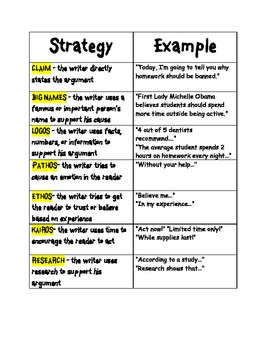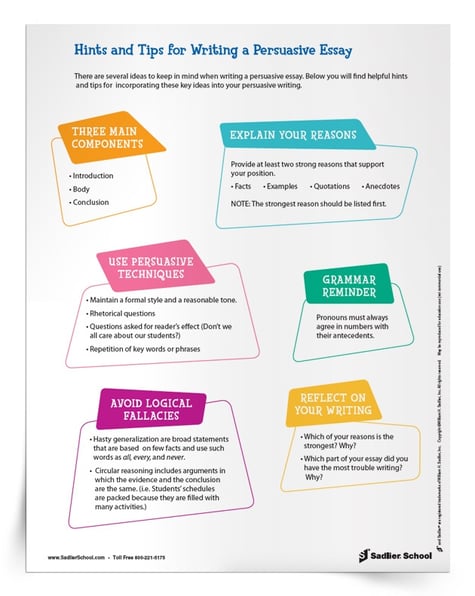
What is persuasive writing?
· Persuasive writing tips and strategies 1 Choose wording carefully Word choice —the words and phrases you decide to use—is crucial in persuasive writing as a way to build a personal relationship with the reader. You want to always pick the best possible words and phrases in each instance to convince the reader that your opinion is right We will learn about nine persuasive strategies that you can use to more effectively influence audience members’ beliefs, attitudes, and values. They are ethos, logos, pathos, positive motivation, negative motivation, cognitive dissonance, appeal to safety needs, appeal to social needs, and appeal to self-esteem needs. Ethos, Logos, and Pathos The definition of persuasive is “to persuade someone to do or believe something through reasoning.” The definition of engage (ment) is “to occupy, attract, interest, or to get someone’s attention.” You might now see that these two things work hand in hand. To persuade someone, you must first engage them. How Does Engagement Work?

Ethos, Logos, and Pathos
The definition of persuasive is “to persuade someone to do or believe something through reasoning.” The definition of engage (ment) is “to occupy, attract, interest, or to get someone’s attention.” You might now see that these two things work hand in hand. To persuade someone, you must first engage them. How Does Engagement Work? · Persuasive writing tips and strategies 1 Choose wording carefully Word choice —the words and phrases you decide to use—is crucial in persuasive writing as a way to build a personal relationship with the reader. You want to always pick the best possible words and phrases in each instance to convince the reader that your opinion is right We will learn about nine persuasive strategies that you can use to more effectively influence audience members’ beliefs, attitudes, and values. They are ethos, logos, pathos, positive motivation, negative motivation, cognitive dissonance, appeal to safety needs, appeal to social needs, and appeal to self-esteem needs. Ethos, Logos, and Pathos

Dissonance, Motivation, and Needs
The definition of persuasive is “to persuade someone to do or believe something through reasoning.” The definition of engage (ment) is “to occupy, attract, interest, or to get someone’s attention.” You might now see that these two things work hand in hand. To persuade someone, you must first engage them. How Does Engagement Work? · Persuasive writing tips and strategies 1 Choose wording carefully Word choice —the words and phrases you decide to use—is crucial in persuasive writing as a way to build a personal relationship with the reader. You want to always pick the best possible words and phrases in each instance to convince the reader that your opinion is right We will learn about nine persuasive strategies that you can use to more effectively influence audience members’ beliefs, attitudes, and values. They are ethos, logos, pathos, positive motivation, negative motivation, cognitive dissonance, appeal to safety needs, appeal to social needs, and appeal to self-esteem needs. Ethos, Logos, and Pathos
Why is persuasive writing important?
The definition of persuasive is “to persuade someone to do or believe something through reasoning.” The definition of engage (ment) is “to occupy, attract, interest, or to get someone’s attention.” You might now see that these two things work hand in hand. To persuade someone, you must first engage them. How Does Engagement Work? · Persuasive writing tips and strategies 1 Choose wording carefully Word choice —the words and phrases you decide to use—is crucial in persuasive writing as a way to build a personal relationship with the reader. You want to always pick the best possible words and phrases in each instance to convince the reader that your opinion is right We will learn about nine persuasive strategies that you can use to more effectively influence audience members’ beliefs, attitudes, and values. They are ethos, logos, pathos, positive motivation, negative motivation, cognitive dissonance, appeal to safety needs, appeal to social needs, and appeal to self-esteem needs. Ethos, Logos, and Pathos
· Persuasive writing tips and strategies 1 Choose wording carefully Word choice —the words and phrases you decide to use—is crucial in persuasive writing as a way to build a personal relationship with the reader. You want to always pick the best possible words and phrases in each instance to convince the reader that your opinion is right We will learn about nine persuasive strategies that you can use to more effectively influence audience members’ beliefs, attitudes, and values. They are ethos, logos, pathos, positive motivation, negative motivation, cognitive dissonance, appeal to safety needs, appeal to social needs, and appeal to self-esteem needs. Ethos, Logos, and Pathos The definition of persuasive is “to persuade someone to do or believe something through reasoning.” The definition of engage (ment) is “to occupy, attract, interest, or to get someone’s attention.” You might now see that these two things work hand in hand. To persuade someone, you must first engage them. How Does Engagement Work?
No comments:
Post a Comment